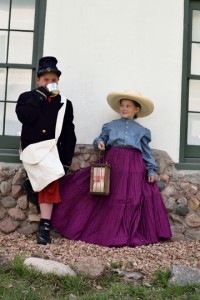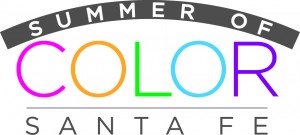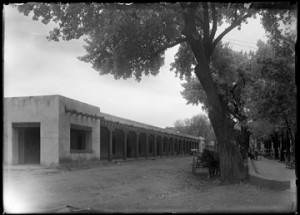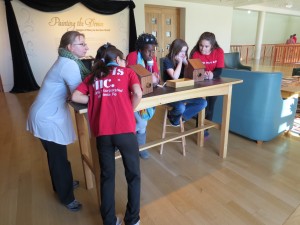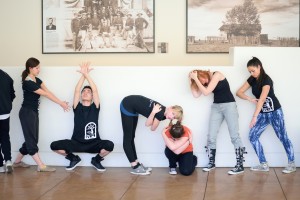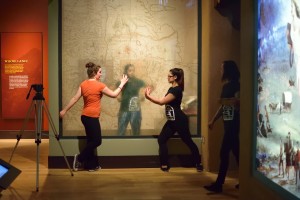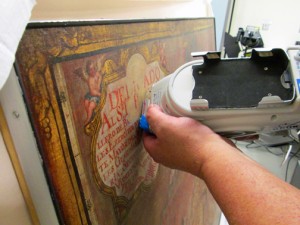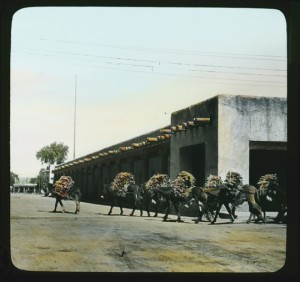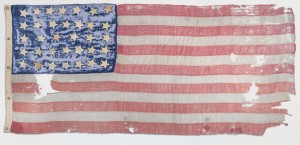
In 1861, as the Civil War broke out across the nation, General Sibley, a confederate from Texas, signed up with Jefferson Davis in a plan to overtake New Mexico, Colorado and eventually California. The New Mexico Territory braced for a series of battles and sent requests to Colorado for support. Men signed up for war, and the women of Denver responded as well. In August 1861, the Ladies of Denver presented a hand-stitched 34-star flag to the recently formed First Colorado Infantry, Company D. The flag and its bearer advanced to New Mexico and a date with infamy in Glorieta Pass.
Meredith Davidson, curator of 19th– and 20th-century Southwest collections, recently traveled with Registrar Deborah King to History Colorado, which now holds the battle-scarred flag. Thanks to a generous loan, they brought it back to New Mexico, where it will become a cornerstone piece for the Mezzanine Gallery exhibit, Fading Memories: Echoes of the Civil War, opening May 1.
The exhibit gives the museum a chance to partner with the Santa Fe Opera, which debuts Cold Mountain this August. To pull it off, Davidson joined Palace Press Director Tom Leech and Photo Curator Daniel Kosharek to present various types of artifacts that represent the opera’s story of loss, relationships and memory, all within the context of the Civil War.
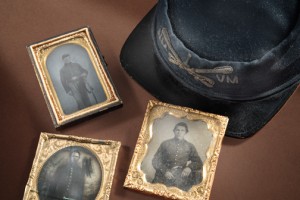 The flag will share space with cased images, postwar lithographs, journals, weapons and a cross worn by a soldier at the decisive battle in Glorieta. The flag was brought back to Colorado by Michael Ivory, one of the unit’s color-bearers. In the 1960s, it was donated to History Colorado.
The flag will share space with cased images, postwar lithographs, journals, weapons and a cross worn by a soldier at the decisive battle in Glorieta. The flag was brought back to Colorado by Michael Ivory, one of the unit’s color-bearers. In the 1960s, it was donated to History Colorado.
“There is something amazing in the way artifacts can carry stories in their very fibers,” Davidson said, “and this flag, with so much physical loss over time reflects the way we as curators and museums must work together to ensure that these totems of memory do not lose those stories.”
The condition of the flag when it was donated to History Colorado led to an initial conservation effort in 1963. Another effort in 1994 noted the flag’s condition had worsened. One area of the description suggests it was, “extremely tattered in some places and generally structurally weak in the star field. Almost 50 percent of that field is lost and shows tattering, tears and detached sections.” The flag may have survived battle, but in the years since its wool stripes and stars were slowly ripping apart,” Davidson said. “Our request to borrow it led to History Colorado undertaking a new conservation effort, this time with more stabilizing, cleaning, and stitching to enable the piece’s long-term display.
Perhaps in error or with the intention to present the flag vertically, the flag was stitched down to a backing with the canton (the part with the stars) on the right. That 1963 choice sealed the fate of the flag for future presentations. Because so much of the blue fabric was lost, the 2014 curators and conservators chose to leave it in place and created a sheer overlay within the canton for extra support.
Getting the nine-foot-long flag to Santa Fe required packing it into a box truck that then weaved back through the Cimarron Pass the flag likely traveled once before. “It is hard to imagine a young soldier, flag in hand, carrying the piece through the landscape and holding it high as a color bearer during the battle itself,” Davidson said. “Museums are places to tell stories, but they are also places to keep what remains once the stories told orally pass. Artifacts are gateways into these stories, and sometimes they just need a little help.”
 Want to get in on the ground floor of collecting from a future Native arts star? On July 4 and 5, the Young Native Artists Show & Sale returns to the Palace Courtyard, from 9 am to 4 pm. Children and grandchildren of artists who belong to the Native American Artisans Program will show off their latest works of art, learn a few tricks of the customer-service trade, and possibly launch a career.
Want to get in on the ground floor of collecting from a future Native arts star? On July 4 and 5, the Young Native Artists Show & Sale returns to the Palace Courtyard, from 9 am to 4 pm. Children and grandchildren of artists who belong to the Native American Artisans Program will show off their latest works of art, learn a few tricks of the customer-service trade, and possibly launch a career.

